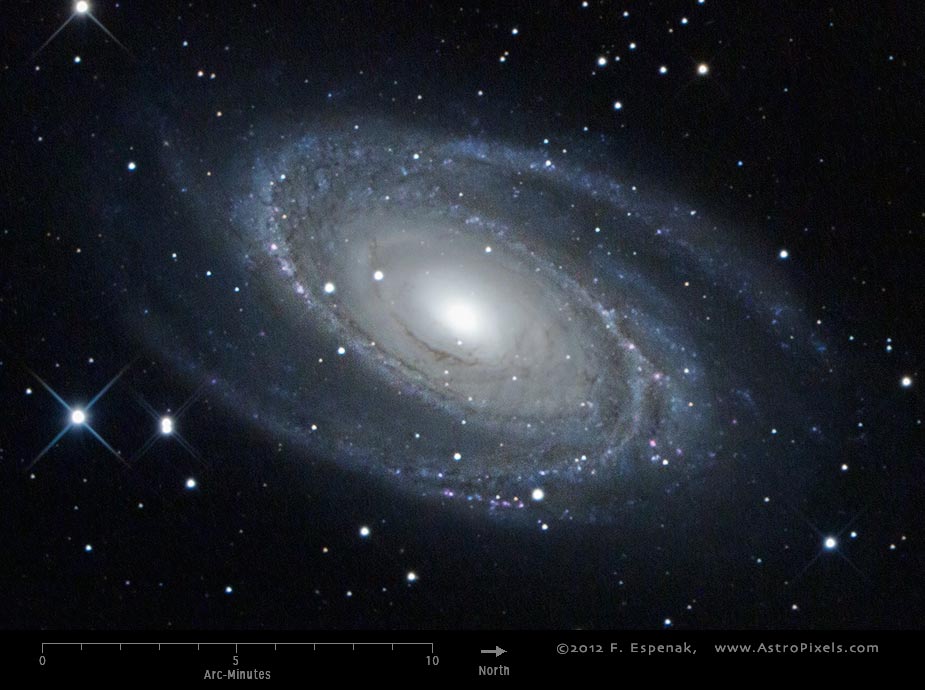M81 - Bode´s Galaxy
Messier 81 or M81 (also designated NGC 3031) is a spiral galaxy in the constellation Ursa Major. It has an apparent visual magnitude of 6.9 and its angular diameter is 21x10 arc-minutes. M81 lies at an estimated distance of 12 million light years. The Equinox 2000 coordinates are RA= 9h 55.6m, Dec= +69° 04´ which makes M81 best seen during the spring. The Messier Spring Star Chart shows the position of all Messier objects visible during that season. As one of the more famous objects in the Messier Catalog, it is commonly known as the Bode´s Galaxy.
The image above shows the uncropped view of M81 (bottom) and M82 (top) through the ASA N12 Corrected Newtonian Astrograph (North is to the right). A 3x enlargement of this image centered on M81 appears to the right.
In spite of its inclusion in the Messier Catalog, this spiral galaxy was actually discovered by J. E. Bode in 1774. M81 and M82 are the brightest members of the M81 Group of galaxies in Ursa Major.
According to Stoyan et al. (2010), the distance of M81 is 11.8 million light years and its diameter is 92,000 light years. Its estimated mass is 50 billion solar masses.
For more information, see the Messier Catalog as well as specific entries for M81 in Wikipedia and SEDS.
Messier's Description of M81
February 9, 1781
`A nebula near the ear of the great Bear [Ursa Major], on the parallel of the
star d, of fourth or fifth magnitude: its position was determined from
that star. This nebula is a little oval, the center clear, and one can see
it well in an simple refractor of 3.5 feet. It was discovered by M. Bode
at Berlin on December 31, 1774, and by M. Méchain, in the month
August 1779.'
Technical Details
- Object: M81
- Other Names: NGC 3031, Bode´s Galaxy
- Object Type: spiral galaxy
- Object Data: Apparent Magnitude = 6.9, Angular Size = 21x10 arc-minutes
- Object Position (Equinox 2000): RA= 9h 55.6m, Dec= +69° 04´, Constellation = Ursa Major
- Date/Time: 2012 Mar 22 at 03:11 UTC
- Location: Bifrost Astronomical Observatory, Portal, AZ
- Mount: Astro-Physics 1200GTO
- Telescope: ASA N12 Corrected Newtonian Astrograph
- Camera: Canon EOS 550D (Rebel T2i) (modified with a Baader UV/IR filter)
- Field of View: 71.0 x 47.4 arc-minutes at 0.82 arc-sec/pixel (web version: 4.6 arc-sec/pixel)
- Exposure: 10 x 420s, f/3.6, ISO 800
- File Name: M81-A01w.jpg
- Processing (Adobe Camera Raw): Flat Field Subtraction, Noise Reduction, White Balance
- Processing (Photoshop CS5): Average Images, Curves, Noise Reduction, High Pass Filter, Unsharp Mask
- Original Image Size: 3454 × 5179 pixels (17.9 MP); 11.5" x 17.3" @ 300 dpi
- Rights: Copyright 2012 by Fred Espenak. All Rights Reserved. See: Image Licensing.
